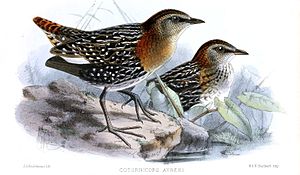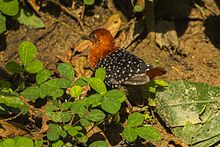Broom tail claws
| Broom tail claws | ||||||||||||
|---|---|---|---|---|---|---|---|---|---|---|---|---|

Mirror rail ( Sarothrura ayresi ), drawing by John Gerrard Keulemans |
||||||||||||
| Systematics | ||||||||||||
|
||||||||||||
| Scientific name | ||||||||||||
| Sarothruridae | ||||||||||||
| Verheyen , 1957 |


The broom tail claws (Sarothruridae) are a family of the crane birds (Gruiformes). It comprises eleven species in two genera and occurs in Madagascar and, with the exception of the arid areas in Botswana, Namibia, South Africa and Kenya, in a large area of sub-Saharan Africa.
features
Broom tail claws have a compact, oval body, a medium-sized, slightly elongated head and a short, thick neck. The beak of the Sarothrura species is short, that of the two Mentocrex species a little longer. The wings are short and rounded, the tail is very short. The legs are of medium length, the feet are strong. The basic color of the birds is red-brown, the head is generally red-brown, brownish or black-and-white stripes or spots can also be present on the trunk.
Way of life
Broom tail claws live in swamps, damp grasslands, thickets and forests. They feed on insects, snails, other invertebrates and small vertebrates, e.g. B. of frogs. Some Sarothrura species also eat seeds or different parts of plants. Since the birds live very hidden, little is known about their reproduction. Probably both genera are monogamous and both parents breed and take care of the young. The females lay two to six eggs and the chicks leave the nest a short time after hatching.

Genera and species
Two genera and eleven species belong to the broom tail claws:
-
Mentocrex
- Tsingyralle ( Mentocrex beankaensis ), Madagascar
- Gray-throated rail ( Mentocrex kioloides ), Madagascar
-
Sarothrura
- Striped rail ( Sarothrura affinis ), Africa
- Mirror rail ( Sarothrura ayresi ), Ethiopia
- Boehmralle ( Sarothrura boehmi ), Africa
- Teardrop rail ( Sarothrura elegans ), Africa
- Hovaralle ( Sarothrura insularis ), Madagascar
- Ugallaralle ( Sarothrura lugens ), Africa
- Pearl rail ( Sarothrura pulchra ), Africa
- Red and breast trap ( Sarothrura rufa ), Africa
- Lemurs Ralle ( Sarothrura watersi ), Madagascar
At times the eye rail ( Canirallus oculeus ) also belonged to the broom tail claws. In the meantime, however, it has been found that it occupies a basal position within the rails.
Systematics
The genus Sarothrura was introduced in 1890 by the German ornithologist Ferdinand Heine , and Mentocrex in 1932 by the US ornithologist James Lee Peters . Sarothrura and Mentocrex were assigned to the Rallen (Rallidae). However , an investigation carried out with the help of DNA comparisons showed that the genera Sarothrura and Mentocrex are more closely related to the Malagasy rush rushes (Heliornithidae) than to the other rams. Both genera were therefore assigned to the Sarothruridae family, which was introduced by Rudolf Verheyen in 1957 . The Aptornithidae, a family of extinct flightless birds that were native to New Zealand, are closely related to the Sarothruridae.
supporting documents
- ↑ a b c d David W. Winkler, Shawn M. Billerman, Irby J. Lovette: Bird Families of the World: A Guide to the Spectacular Diversity of Birds. Lynx Edicions (2015), ISBN 978-8494189203 , p. 109 and 110.
- ↑ a b Flufftails, finfoots, rails, trumpeters, cranes, limpkin . In: World Bird List Version 9.2 . International Ornithologists' Union. 2019. Retrieved December 25, 2019.
- ↑ Richard O. Prum et al. A comprehensive phylogeny of birds (Aves) using targeted next-generation DNA sequencing. Nature, October 7, 2015; doi: 10.1038 / nature15697
- ↑ Alexander P. Boast, Brendan Chapman, Michael B. Herrera, Trevor H. Worthy, R. Paul Scofield, Alan JD Tennyson, Peter Houde, Michael Bunce, Alan Cooper and Kieren J. Mitchell. Mitochondrial Genomes from New Zealand's Extinct Adzebills (Aves: Aptornithidae: Aptornis ) Support a Sister-Taxon Relationship with the Afro-Madagascan Sarothruridae. Diversity, 2019 DOI: 10.3390 / d11020024